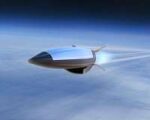Lockheed Martin’s Skunk Works division has publicly revealed its ‘Vectis’ uncrewed combat aircraft concept—an AI-enabled stealth platform positioned to meet the U.S. Air Force’s requirements for a Collaborative Combat Aircraft (CCA). The unveiling marks Lockheed’s most detailed vision yet for a next-generation loyal wingman designed to fly alongside crewed fighters like the F-35 and NGAD.
Vectis Concept: A Glimpse into Lockheed’s CCA Strategy
Unveiled at the 2024 Air & Space Forces Association Warfare Symposium in Aurora, Colorado, the Vectis concept represents Lockheed Martin’s formal entry into the U.S. Air Force’s CCA competition. The design was showcased with digital renderings and a scale model bearing low-observable features—angled surfaces, blended body-wings, and internal payload bays—suggesting a strong emphasis on survivability in contested airspace.
The name “Vectis” is Latin for “lever,” symbolizing its intended role as a force multiplier. According to John Clark, vice president and general manager of Skunk Works, Vectis is not just a drone but an “AI-enabled teammate” that can extend sensor reach, carry additional weapons or EW payloads, and perform high-risk missions without endangering human pilots.
Designed for Modularity and Mission Flexibility
Lockheed emphasized that Vectis is built around open systems architecture—a key requirement of the CCA program—to allow rapid integration of new sensors, autonomy packages, or mission payloads. This modularity supports multi-mission roles such as:
- Electronic warfare (EW) jamming or deception
- Suppression/destruction of enemy air defenses (SEAD/DEAD)
- ISR with EO/IR or RF sensors
- Aerial refueling relay or comms node functions
- Kinetic strike with precision-guided munitions
The design also supports scalable autonomy—from remote piloting to full AI-driven operation—depending on mission complexity and rules of engagement. This aligns with USAF goals to field CCAs that can operate semi-independently in GPS-denied or jammed environments while remaining under human oversight when needed.
A Stealthy Escort Built for NGAD Integration
While Lockheed has not released specifications such as range or payload capacity, renderings suggest a medium-sized UCAV optimized for low observability and internal carriage. Its planform resembles other stealthy drones like Boeing’s MQ-28 Ghost Bat or Kratos’ XQ-58A Valkyrie but appears more refined in terms of shaping and inlet design.
The aircraft is expected to integrate seamlessly with sixth-generation fighter platforms under the Next Generation Air Dominance (NGAD) family-of-systems architecture. In this context, Vectis would serve as an escort drone capable of penetrating contested airspace ahead of or alongside manned fighters—absorbing risk while extending sensor coverage and weapons reach.
Competitive Landscape: Boeing vs Lockheed vs Anduril
The USAF plans to downselect two vendors by late FY2024 to build production-representative prototypes under its CCA Increment One effort. Boeing has already flown multiple XQ-58A Valkyries under Skyborg testing; Anduril Industries recently unveiled its Fury platform; General Atomics continues work on its Gambit series; Northrop Grumman remains secretive but confirmed participation.
Lockheed’s advantage lies in its deep integration with existing USAF systems—particularly F-35—and decades-long experience in stealth design via Skunk Works programs like the U-2 Dragon Lady, F-117 Nighthawk, F-22 Raptor and NGAD demonstrators. However, it faces pressure from more agile players offering lower-cost attritable platforms with faster development cycles.
AI Autonomy and Digital Engineering at Core
A key differentiator of Vectis is Lockheed’s focus on digital engineering tools and AI autonomy frameworks developed under Project Hydra and DARPA programs like ACE (Air Combat Evolution). These tools enable rapid iteration through simulation before physical prototyping—a critical advantage given the USAF’s aggressive timelines.
The company also emphasized trustable autonomy—ensuring that human operators can predictably command drone behavior even in complex environments. This includes onboard decision aids powered by machine learning algorithms trained on thousands of simulated combat scenarios involving dynamic threats.
Toward Fielding by Late Decade
The first operational CCAs are expected to enter service around FY2028–2030 as part of NGAD Increment One. The Air Force envisions fielding hundreds of these drones at unit costs between $10–25 million depending on capabilities—a fraction of manned fighter costs but still requiring high reliability and interoperability standards.
If selected later this year for prototype development contracts (potentially worth billions over time), Lockheed will likely leverage advanced manufacturing facilities already supporting classified programs at Palmdale Plant 42. Flight testing could begin within two years if funding aligns with current schedules.









